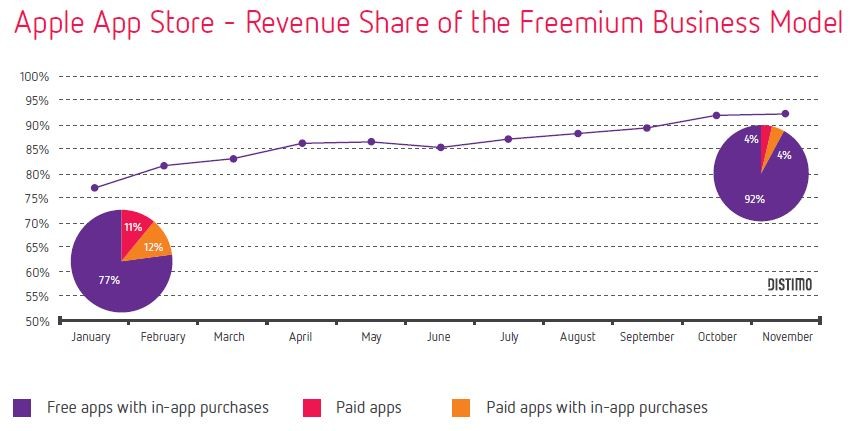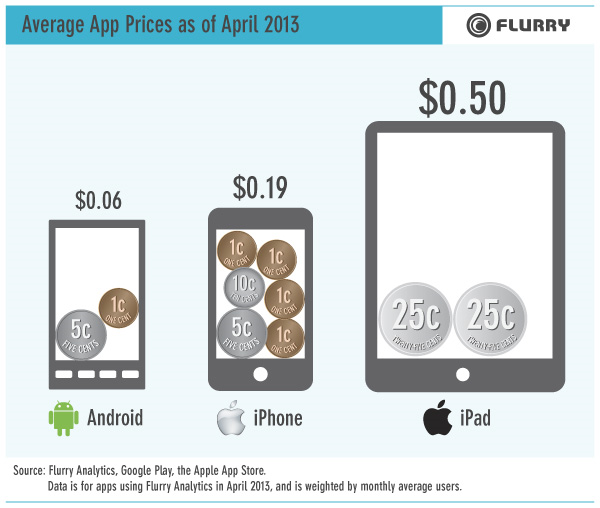In this article, I'll talk about the different business models of mobile applications and which one is the right choice for you.
Introduction
You've worked for weeks or even months on your first mobile application and it's ready for prime time. The next step, of course, is to publish it to Apple's App Store if it's an iOS application or Google Play if you're targeting the Android platform. One of the question you should ask yourself is "How much should my application cost?" $0.99? $1.99? $10.99? Free? In this article, we'll consider your options and decide which one is the road to success and which one isn't.
Revenue Sources
Say you've just developed a great application. Great. You can't wait to publish it and let the cash pour in. Should you make it free? Or should you charge $0.99 for it. Or maybe even as high as $1.99? Surely, the average consumer won't mind paying $2.99 for such a nice application. Or would they? Not quite. Consumers are getting less and less willing to pay for mobile applications. Instead they search for free alternatives. From a developer's point of view, though, free applications aren't free. They build a user base first and generate revenue through ads shown in the application or through in-app purchases or subscriptions. This is the so-called freemium model.
According to a recent report by Distimo, 92% of the total revenue earned in Apple's App Store in November 2013 came from in-app purchases in free applications, up from 77% in January 2013. Only 4% came from paid applications and 4% from paid applications with in-app purchases. This trend is also visible in Google Play. In November 2013, 98% of the total revenue came from in-app purchases in free applications, up from 89% in January 2013. Only 1% came from paid applications and 1% came from paid applications with in-app purchases. The percentages of free applications with in-app purchases continues to climb.


Free with In-App Purchases
How do you make money with a free application? In-app purchases are a good option. Users who like your application are likely to buy one or more in-app purchases (IAPs). That means that you buy virtual goods for a price from within your application. An in-app purchase can be used in many forms.
- Paid Subscription: This works well for magazine and newspapers.
- Virtual Currency: This is a very popular approach for free games.
- Unlock Features: This is another popular option for games to sell additional levels.
- Game Boosters: This is similar to selling virtual currency and frequently found in games that are tough to get through.
- Lives: This strategy is a variant of game boosters. Candy Crush Saga is a good example of this strategy.
- Paid Ad Removal: This approach is great if you want to allow users to upgrade from a free version to a paid version.
When used appropriately, in-app purchases can generate a lot of revenue. Candy Crush Saga, one of the recent top grossing games in Apple's App Store, generates around $950,000 in revenue ... every day.
Free with Ads
Advertising is another way to make money from free applications. Mobile advertising works well in one of the following forms, cost per click (CPC), cost per mile (CPM), and cost per action (CPA). CPC means that you earn money every time someone clicks on one of your ads. This can be very profitable, but the amount of money you earn largely depends on how many people are using your application, how interesting the ads you serve are, and how high the CPC rate is. For some categories, you can earn up to $0.05-$0.1 per click, while you can barely earn $0.001 per click for others.
CPM means that the ad network pays developers a certain rate for every 1000 views (not clicks). To generate large amounts of revenue from CPM ads, you need a large use base that view the ads every time they use your application.
CPA stands for cost-per-action, which means that developers get paid every time a user accepts and completes an offer, such as filling out a survey, downloading an application, buying a product, etc. The rates are very high, sometimes as high as $1-$2 per action. A common method would be asking the user to complete an action and giving the user something in return, such as virtual currency.
One common problem with ads is fill rate. This is the number of ads the application requests from the publisher, such as Google, divided by the number of ads received from the publisher. If you use Apple's iAd network, for example, it might not display an ad every time someone uses your application. In fact, no advertising network has a 100% fill rate. Using an ad network with a lower fill rate will significantly reduce your potential earnings even if you get a higher CPC. To make the most money with ads in an application, you need to keep track of the following three elements.
- A great application: Many applications aren't the first in their segment, but they're the best and that's why they are successful.
- Build a Large User Base: If you aim to earn money through advertising, you'll need a large user base. Making money with ads is a numbers game.
- Relevant Ads: Not any ad will do. Unless your paid by impressions (CPM), you won't make much money if the ads you serve are dull, not relevant, or unattractive.
Here's a list of recommendations for some good ad networks you can use in your applications.
- Apple's iAd
- Google's AdMob
- Mobpartner
- Leadbolt
- Inmobi
- Revmob
What's the best mobile advertising network? The truth is that there is no one best network. Experiment with several networks and find out which one(s) work best for your application. I'd recommend starting with iAd for iOS applications and AdMob for the Android platform.
Paid: How does it work?
You've worked really hard on your application and you've invested time and money in your project. Why shouldn't users pay for such a great, fun, and useful application? It that's the way you feel about it, then you should probably go for a paid business model. There's one important question to answer though. How much should you charge? $0.99? $1.99? More? $0.99 is a good price for a paid application. The truth is that $0.99 is the minimum you can charge in most mobile stores. How about $1.99? That would be pushing it a bit. Users might not want to spend $1.99 on an application that they have never used before. That's why it's always a good idea to include several screenshots and maybe even a video if possible. Anything above $2.99 won't make you a lot of money. Users only tend to spend that much money on an application if it's from a reputable company or many of their friends are using and enjoying it.
Still, some applications have made a lot of money with the paid model, for example Doodle Jump and Minecraft Pocket Edition. In fact, Minecraft Pocket Edition was one of the top grossing applications in Apple's App Store. The surprise is that it's priced at a whopping $6.99. However, Minecraft Pocket Edition's success can for the most part be attributed to the success of the original Minecraft game, which is still insanely popular.
The popularity of paid applications varies from category to category. Applications in the productivity, navigation, and education categories are more likely to hit the top grossing charts than applications of other categories. Why is that? One explanation is that these types of applications are considered an investment by consumers, while games and social networking applications are aimed at users who are looking for fun and entertainment.

Conclusion
Let's go back to the original question "How should you price your application?" Let's take a look at a trend in the mobile space from a post by Mary Ellen Gordon over at Flurry. The percentage of free applications on the App Store has risen from 84% in 2010 to 90% in 2013. This means that the percentage of paid applications has fallen from 16% to 10% in that same period.
Users are getting less and less willing to pay for applications.
What does this tell us? Users are getting less and less willing to pay for applications, instead preferring free alternatives with in-app purchases or ads. What's more, Android users are even less willing to pay for applications.


Here are my suggestions.
- For the freemium model, include in-app purchases to generate revenue. You could also publish a lite version and a separate paid version that includes premium features.
- For free applications, monetize your applications with in-app purchases and ads. Be careful to not show too many ads as you may scare away users.
- Opt for the paid model if your application stands out from the rest by offering unique features or targets a premium market. Keep in mind that it's best to price it under $2.99.
I hope you've learned something from this article. If you have any questions or comments, feel free to leave a comment below. I'll do my best to answer them.


Comments